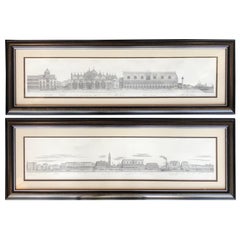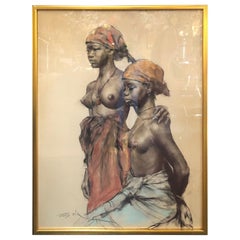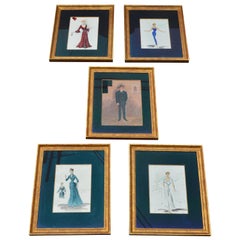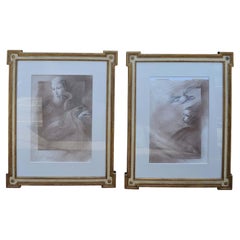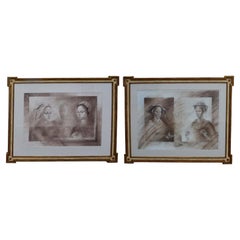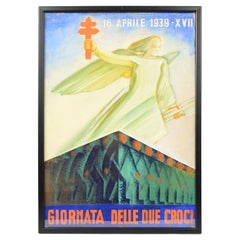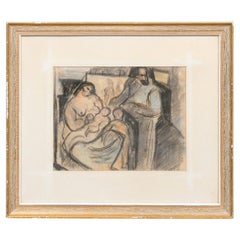Pegaso Gallery Design Drawings
to
5
5
Height
to
Width
to
5
1
1
3
1
4
1
1
2
2
2
1
1
5
5
5
2
1
Two Engravings of Italian Cityscapes
Located in Los Angeles, CA
Two panoramic engravings of Italian cityscapes by ports.
Category
Early 20th Century Italian Drawings
Materials
Paper
$3,200 / set
Two African Women, Pastel on Paper by Pal Fried
By Pal Fried
Located in Los Angeles, CA
Two African Women pastel on paper by Pal Fried, an American/Hungarian artist. From the estate of Zsa Zsa Gabor. Newly framed.
Category
Mid-20th Century American Drawings
Materials
Paper
Set of 5 Artistic Sketches for Movies
Located in Los Angeles, CA
Set of 5 artistic sketches for movies, studio props made in water color.
Category
Vintage 1980s American Drawings
Materials
Other
Set of Two Charcoal and Pencil Drawings
By Peter Nickel
Located in Los Angeles, CA
Two mixed-media portraits of women. Pencil and charcoal. The frames are 19th century but the art work is signed Peter Nickel 1987.
Category
Late 20th Century Drawings
Materials
Paper
$5,200 / set
Set of Two Pencil and Charcoal Portraits
By Peter Nickel
Located in Los Angeles, CA
Two mixed-media portraits of women. Pencil and charcoal. The frames are 19th century but the art work is signed Peter Nickel 1987.
Category
Late 20th Century English Drawings
Materials
Paper
$5,800 / set
Related Items
Italy 1939s Sketch Futurist Poster "Day of Two Crosses" Against Tuberculosis
By Fortunato Depero
Located in Milan, IT
Sketch of the futurist poster "Day of two crosses, 16th April 1939, XVII", mixed technique of pastel and water-color, for an Italian campaign against tuberculosis, to inform people a...
Category
Vintage 1930s Italian Futurist Scientific Instruments
Materials
Paper
$1,417
H 20.48 in W 14.57 in D 0.12 in
Framed Charcoal Drawing, Signed and Dated 1938
Located in Atlanta, GA
Framed Charcoal Drawing, Signed and Dated 1938
Category
20th Century Drawings
Materials
Paper
Art Deco pastel painting "Nude of a Woman" signed Fried Pal, 1930s
By Pal Fried
Located in Traversetolo, IT
Stupendous pastel painting designed by Fried Pal in the 1930s,the theme of the nude in the Art Deco period was of important relevance,the author in this painting demonstrates great s...
Category
Vintage 1930s American Art Deco Paintings
Materials
Glass, Wood, Paper
$3,425
H 34.26 in W 26.38 in D 2.76 in
Pal Fried Nude Portrait Oil on Canvas
By Pal Fried
Located in San Diego, CA
Nude portrait oil on canvas by Hungarian/American artist Pal Fried. Excellent overall condition in period frame with a light vertical scratch line running along the lower middle as s...
Category
Mid-20th Century American Art Deco Paintings
Set of 3 x 19th Century Charcoal Drawings
Located in Ongar, GB
A lovely set of 3 x antique charcoal drawings in later frames. Circa 1900.
Category
Antique 1890s European Drawings
Materials
Parchment Paper
Gouache, Charcoal and Pastel on Paper, Mid-Century Drawing of a Ballerina
Located in San Francisco, CA
The abstract expressionist drawing of a graceful ballerina dancing to Swan Lake in a deep bow; with illegible signature.
Category
Vintage 1950s North American Expressionist Drawings
Materials
Paper
$1,800 Sale Price
20% Off
H 27 in W 21 in D 1.5 in
Set of 6 19th Century McKenney and Hall Portraits of Native Americans
By McKenney & Hall
Located in Richmond, VA
Set of 6 19th century McKenney and Hall portraits of Native Americans. Hand colored lithographs from: The history of the Indian tribes of North Ameri...
Category
Antique 19th Century American Paintings
Materials
Paper
Pastel on Paper of a Chocolate Lab.
Located in Lambertville, NJ
A 20th Century pastel painting on paper of a chocolate Labrador. Excellent condition of this handsome dog. Signed on lower corner, dated '85.. 17 hi...
Category
Vintage 1980s American Drawings
Materials
Glass, Wood, Paper
Ancient engraving, map of the earth with circling zodiac
Located in Saint-Ouen, FR
Ancient engraving, map of the earth with circling zodiac "Situs Terrae Circulis Coelestibus Circumnate"
Category
Antique 18th Century European International Style Drawings
Materials
Paper
Six Copperplate Engravings of Sculptures in the Garden of Versailles
Located in Vista, CA
Simon Phillippe Thomassin (French, 1638-1722) Collection of six copperplate engravings (no. 173-179) of the sculptures in the gardens of the Palace of Versailles, France, framed alik...
Category
Antique Late 18th Century French Drawings
Materials
Paper
$4,795 / set
H 12 in W 9.5 in D 1.5 in
18th Century Italian Framed Neoclassical Hercules Statues Engravings, Set of 3
Located in Dallas, TX
Add classical gravitas to your space with this elegant set of three antique engravings depicting views of ancient Hercules sculptures. Printed in Rome in the 18th century, each print...
Category
Antique Late 18th Century Italian Neoclassical Drawings
Materials
Glass, Giltwood, Paper
$1,600 / set
H 20 in W 15 in D 1 in
Jan Kristofori Original Pencil Sketches, Set of 3, Authentic Swiss Motives
Located in Hamburg, DE
Welcome to our exclusive online store, where art and authenticity converge. Immerse yourself in the captivating world of Jan Kristofori with our exclusive collection of three original pencil sketches.
Discover Uniqueness:
These artworks are not just sketches; they are artistic masterpieces, hand-drawn and personally signed by Jan Kristofori. Each sketch tells the story of the artist and captures the picturesque beauty of Swiss mountain villages.
Masterful Craftsmanship:
Jan Kristofori's unparalleled craftsmanship is expressed in every fine line. His talent for capturing the captivating landscape of the Prato and Tessin regions creates a connection between art and nature.
A Touch of Swiss Flair:
The artist's sources of inspiration extended across the snow-capped peaks and picturesque villages of Switzerland. These sketches not only reflect his art but also the atmosphere and charm of the Swiss mountain landscape.
A Piece of History in Your Hands:
Each sketch is not just an artwork but a piece of history. With 110 auctions on public platforms, Jan Kristofori has left a lasting impression. Now, you have the opportunity to own a part of this heritage.
Enrich Your Collection:
Enhance your home or office with these unique artworks. The versatility of these sketches allows you to showcase them individually or as a harmonious trio, bringing a touch of elegance to your spaces.
More Motives Available Upon Request:
Discover an even wider range of Jan Kristofori's artistry. If you desire more sketches or specific motives, simply get in touch with us. We have an extensive collection that goes beyond what's showcased here.
Secure Ordering, Worldwide Shipping:
Order today and be enchanted by the art of Jan Kristofori. We offer secure order processing and worldwide shipping, ensuring you can have these masterpieces in your hands soon...
Category
Vintage 1980s Swiss Modern Drawings
Materials
Paper
$413
H 11.42 in W 8.27 in D 0.04 in
